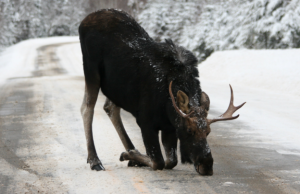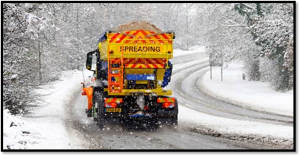Tagged: winter
The taste of salt
Robert Lennox is a PhD student at Carleton University. He is working on Atlantic salmon migration in Norway in Steve Cooke’s lab (more info). He is also an avid naturalist with a special interest in birds.
Every winter the first snowfall brings out an army of trucks, ploughing – and heavily salting – Ottawa’s streets and highways to keep them safe. But safety comes at a price. Not only does it coat our cars and boots, we apply so much road salt in Canada (5,000,000 tonnes a year) that it creates environmental risks.
Much of the salt eventually finds its way by meltwater into local water bodies. There, it poses a risk to fish, freshwater ecosystems, plants, and animals that normally regulate the amount of salt in their bodies but are not adapted to saline water and cannot function properly in it (Rosenberry et al. 1999, Kelly et al. 2007, Environment Canada 2015).
Salt is toxic to wood frog larvae, which live in ponds throughout North America. If these larvae are exposed to salt for long periods they take longer to metamorphose into adult frogs, have physical abnormalities and reduced activity, weight, and survivability (Karakker et al. 2008, Sanzo and Hecnar 2006).
 Large species, such as moose, and small winter finches in the Fringillidae family are attracted to road edges where they can satisfy their salt requirements. However, the downside is they may be struck by passing vehicles (Mineau and Brownlee 2005).
Large species, such as moose, and small winter finches in the Fringillidae family are attracted to road edges where they can satisfy their salt requirements. However, the downside is they may be struck by passing vehicles (Mineau and Brownlee 2005).
To reduce the environmental impact of road salt, most municipalities have adopted the 2004 national code of practice for organizations that apply more than 500 tonnes of salt a year. The code includes measures for salt storage (under cover and on an impermeable pad), application equipment and techniques, and salt vulnerable areas (identifying, monitoring and protecting areas that may be particularly sensitive to road salts).
 Recently, Environment Canada reviewed the effectiveness of the code and set national targets for improved road salt management, notably, an increase in the number of road organizations that identify salt vulnerable areas and prepare an action plan for them.
Recently, Environment Canada reviewed the effectiveness of the code and set national targets for improved road salt management, notably, an increase in the number of road organizations that identify salt vulnerable areas and prepare an action plan for them.
What can we do? Some cities are testing creative solutions, including using garlic salt, cheese brine, and molasses (see news story) as alternatives to road salt on city streets and highways. At home you can try sprinkling sand on your icy paths and walkways, or save and spread some ashes from the yule log (see Road salts and alternatives). Maybe these can be practical solutions for you.
References
Environment Canada. Road salts. January 8, 2015.
Karraker, N.E., Gibbs, J.P., Vonesh, J.R. 2008. Impacts of road deicing salt on the demography of vernal pool-breeding amphibians. Ecological Applications 18(3): 724-734.
Kelly, V.R., Lovett, G.M., Weathers, K.C., Findlay, S.E., Strayer, D.L., Burns, D.J., Likens, G.E. 2007. Long-term sodium chloride retention in a rural watershed: legacy effects of road salt on streamwater concentration. Environmental Science & Technology 42(2): 410-415.
Mineau, P., Brownlee, L.J. 2005. Road salts and birds: an assessment of the risk with particular emphasis on winter finch mortality. Wildlife Society Bulletin 33(3): 835-841. (Abstract)
Rosenberry, D. O., Bukaveckas, P.A., Buso, D.C., Likens, G.E., Shapiro, A.M., Winter, T.C. 1999. Movement of road salt to a small New Hampshire lake. Water, Air, and Soil Pollution 109(1-4): 179-206. (Abstract)
Sanzo, D., Hecnar, S.J. 2006. Effects of road de-icing salt (NaCl) on larval wood frogs (Rana sylvatica). Environmental Pollution 140(2): 247-256.

